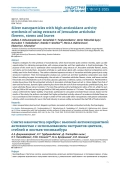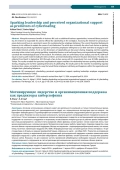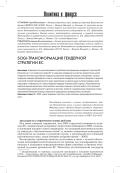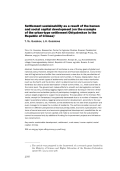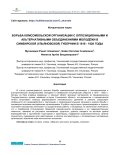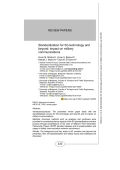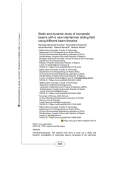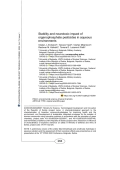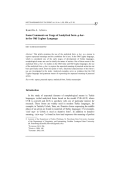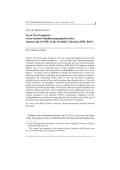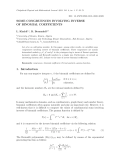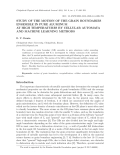Biogenic strategies for the synthesis of nanomaterials, which have become quite common recently, open up wide opportunities for obtaining nanoparticles with unique properties and their application in food technologies. The purpose of this work was to synthesize silver nanoparticles using extracts of Jerusalem artichoke flowers, leaves, and stems and to study them. Jerusalem artichoke is a well-known plant with a unique chemical composition and is widely used in the food industry. The authors obtained aqueous extracts of Jerusalem artichoke ground parts using ultrasonic treatment. Their chromatographic analysis was carried out and their qualitative composition was established. According to paper chromatography, the extracts of Jerusalem artichoke flowers, stems, and leaves contain flavonoids and carbohydrates such as fructose, glucose, galactose, arabinose, xylose, and rhamnose. Potentiometric studies have shown that the antioxidant activity of Jerusalem artichoke flower extract is 4 times higher than that of stem and leaf extract. Dynamic light scattering has shown that the ash of silver nanoparticles synthesized using Jerusalem artichoke flower extract contains 17% more fine particles with a hydrodynamic radius of 54 nm, while the sum of large (300 to 850 nm) and very large (4000 to 5300 nm) particle fractions is 17% lower. The obtained zeta potential values confirmed the higher stability of particles synthesized in Jerusalem artichoke flower extract. Based on the results of the study, the authors concluded that higher antioxidant activity values of Jerusalem artichoke flower extract contribute to the formation of a larger number of fine and stable silver nanoparticles with greater antioxidant activity, which is promising for use in the food industry to ensure safety and extend the shelf life of food products
Alongside numerous benefits in business life (such as additional business opportunities, increased labour productivity), the Internet is responsible for adverse effects like cyberloafing in the workplace. Accessing the Internet for personal purposes during work hours is a prominent reason for counterproductive employee behaviour. The current theoretical background, however, is not sufficient to explain the causes of such behaviour. The article aims to identify the role of such factors as sparking leadership and perceived organizational support in preventing employees’ willingness to use their work time to engage in nonwork-related internet activities. To do so, five dimensions of cyberloafing are discussed: sharing, shopping, real-time updating, accessing online content, and gaming/gambling. Leadership theories, social exchange theory, and organizational support theory constitute the methodological basis of the research. The methods used are confirmatory factor analysis, and the PLS-SEM technique to reach a path model revealing the direct, indirect, and total relationships between the given dimensions. The data were collected from March to September 2023 through a face-to-face survey with 95 respondents from over 40 SMEs operating in Türkiye. The results revealed that perceived organizational support mediates the relationship between sparking leadership and sharing, shopping, and real-time updating dimensions of cyberloafing. The results point to the need for reconsidering organizational practices, values, and policies in a way that would foster employees’ well-being and happiness within the organization and mitigate their cyberloafing behaviour
В данной статье рассматривается проблема трансформации гендерной стратегии ЕС. Несмотря на то что первичное право ЕС по-прежнему определяет в качестве приоритетных целей гендерной политики достижение гендерного равенства между мужчинами и женщинами, в новом гендерном подходе наблюдается отход от классических гендерных постулатов о бинарности мужской и женской половой принадлежности через закрепление на уровне языка и мягких правовых норм нарративов о небинарности и трансгендерной природе человека (SOGI-подход). Реализуемая вне широкой научной дискуссии и политического консенсуса данная стратегия может стать причиной трансформации представлений о мужском и женском, привести к радикальному изменению гетеронормативной бинарной матрицы общества и традиционных репродуктивных установок.
Sustainable development of territories is one of the key goals of global and national policy. However, despite the resonance and financial assistance, many territories still lag behind and suffer from social-economic crises due to the peculiarities of both economic specialization and local communities. In Russia, depopulation has affected not only certain types of settlements and localities but also macro-territories (such as the North and the Arctic), which is determined not only by economic backwardness but also by social atomization of local communities, i. e., weak social ties at the micro level. The government makes efforts to smooth out demographic contrasts within the country, providing lagging regions with additional funding in the form of federal transfers and subsidies (policy of participatory budgeting, national projects, and various target programs to support local projects). The population of the Crimean Peninsula, except for Sevastopol, has gradually decreased due to a number of reasons: the region’s peripheral status, lagging social-economic development, proximity to the war zone, ethnic tensions, etc. However, some settlements do not lose their population and even manage to increase the number of residents. The authors consider one such settlement in different perspectives (historical prerequisites, economic specialization, features of social-economic and economic-geographical development, possibilities for accumulating social and human capital) and make a conclusion that its sustainability cannot be ensured only by additional funding for improvement projects and infrastructure construction.
The article deals with the process of struggle of the Komsomol organization with opposition and alternative associations of youth in Simbirsk (Ulyanovsk) province in 1918 - 1928. The authors on the basis of archival materials from the State Archive of Modern History of the Ulyanovsk region, ego-documents and periodicals, introduced for the first time in the scientific turnover, touch upon the formation of the Komsomol movement in the region, reveal the peculiarities of its interaction with the party and law enforcement agencies in the fight against non-communist youth organizations. The work scrupulously analyzes the process of obtaining the Komsomol monopoly on the implementation of work with young people. In conclusion it is noted that in Simbirsk (Ulyanovsk) provincial Komsomol organization and its subordinate committees, despite the regularly arising difficulties, managed to establish at a high level of interaction with party structures and securing the support of law enforcement agencies to carry out the liquidation of all alternative and opposition youth organizations operating in the region, providing itself a monopoly position.
Introduction/purpose: The presented review paper deals with the standardization proces for 5G technology and beyond and its impact on military communications.
Methods: Dominant methods such as analyzes and syntheses were provided for considering the key aspects of the 5G standardization evolution process through presentations of the roles of different Third Generation Partnership Project (3GPP) standard releases and its implementation and usage in military communication networks environment.
Results: The background and key areas in 5G evolution and beyond are presented. Also, 5G standardization and military issues and challenges are discussed.
Conclusion: Standardization for 5G and the emerging 6G landscape is extremely complex and highly innovative with many rapidly evolving industry-driven and societal requirements. Standard development organizations, industry, and academia need to collaborate on standardization to facilitate worldwide interoperability. The paper gives an overview of standardization functionalities and efforts to improve 5G system performance as well as its impact on military communications and services. It analyzes the areas of major enhancements for the existing features and expansion to new use cases and industries as well as to military usage through the 3GPP Releases, starting from Release 15 as 5G Basic, over 16 and 17 as 5G Evolution, up to 18 and 19 as 5G Advanced which precede the upcoming Release 20 and the initial 6G network whose launch is expected by the end of this decade.
Introduction/purpose: The present work aims to carry out a static and dynamic investigation of composite beams composed of two elements connected together, with a partial interaction between the beam layers, while taking into account the interlaminar sliding effect.
Methods: A new interlaminar slip field which takes into account, for each layer, the axial displacement, the rotation due to bending, and the high-order transverse shear with a new warping shape function, has been introduced in this study. The equilibrium equations were solved analytically based on the principle of Hamilton. In addition, the numerical resolution of these equations was based on the principle of minimizing all energies using the Ritz method, while taking into account different beam theories. Afterwards, a comparative study was carried out in order to calculate the natural vibration frequencies of two composite beams made of steel and wood materials.
Results: It was found that the results obtained for the ten natural vibration frequencies are in perfect agreement with those reported in previous works found in the literature.
Conclusion: Further, a detailed study was conducted, depending on the geometric and material parameters, for the two mixed materials, i. e., concrete-wood and steel-concrete, with two interlaminar sliding fields, namely the classical sliding field based on the Timoshenko beam theory and a new interlaminar sliding field that is based on the high order theory. Furthermore, bending was studied in the static case in order to examine the effect of the interlaminar shear force on short and long beams.
Introduction/purpose: Organophosphates are widely used nowadays. They have applications as pesticides, drugs, plasticizers, flame retardants, or chemical warfare agents. Their acute toxicity is ascribed to inhibiting acetylcholinesterase (AChE), a key enzyme in the transmission of nerve impulses in animals. Their toxic effects manifest by acetylcholine accumulation in the nerve synapses and can lead to paralysis or death. Organo-thiophosphate pesticides (OPs) are used in large quantities. Their oxo-analogs can also be found in the environment due to oxidation. Once accumulated in the environment, they exhibit toxic effects on non-target organisms.
Methods: The hydrolysis of OPs in different pH was systematically analyzed, and their neurotoxic effects were evaluated. The concentration of the investigated pesticides during decomposition was monitored by ultra-performance liquid chromatography (UPLC). At the same time, a decrease in the toxicity of the treated samples was observed by measuring the activity of the enzyme AChE.
Results: OPs decompose rapidly in alkaline aqueous solutions but are highly stable in acidic solutions. Chlorpyrifos hydrolyzes the fastest and dimethoate the slowest. The toxicity of these OP solutions decreases over time, indicating that more toxic products were not formed.
Conclusion: The presented results can provide a sound basis for further efforts to find simple and efficient decomposition methods of OPs.
This article examines the use of the analytical form -p bar- as a means to express aspectual meanings and the conditions for its use. In the Old Uyghur language, which is considered one of the early stages of development of Turkic languages, morphological means are used to clarify the nature of actions. One of these means is the analytical form -p bar-. In studies on the Old Turkic and Old Uyghur languages, the use of the analytical form -p bar- to express the aspectual meaning of punctual action has not been previously noted. From this point of view, functional characteristics of this form’s use are investigated in the study. Analyzed examples serve as evidence that the Old Uyghur language had grammar means of expressing the aspectual meaning of punctual action.
The present paper introduces seven new manuscript fragments that have been identified with the Sanskrit Buddhist text — the Lotus Sūtra (Skt. Saddharmapuṇḍarīka). Until quite recently these fragments have had no pressmark and were revealed among the unregistered materials of the Serindia Collection (IOM, RAS). The fragments represent different parts of seven pothi-type leaves of paper containing Sanskrit text in South Turkestan Brāhmī script, which was used for recording Buddhist texts in the 8–9 cc. AD in Khotan — the largest center of Mahāyāna in Serindia (the Eastern part of Central Asia within the current borders of Xinjiang). Seven fragments bear clear similarities in terms of paleographic and codicological features (type of script, size and shape of graphemic symbols (akṣaras), number of lines and line-spacing, paper characteristics etc.). Given the express similarities, it is reasonable to assume that all the fragments could belong to one and the same manuscript. Furthermore, it was revealed that two new fragments almost join with those kept under the pressmarks SI 1934 and SI 6584 and represent altogether two relatively complete pothi leaves. After the identification and investigation these seven new fragments were assigned the inventory number and the pressmark SI 6781. This paper includes description of the fragments SI 6781, transliteration, comparison with the corresponding text of the Petrovsky manuscript (the most complete Central Asian copy of the Sanskrit Lotus Sūtra), English translation, and facsimile of two fragments.
Let p be an odd prime number. In this paper, among other results, we establish some congruences involving inverse of binomial coefficients. These congruences are mainly determined modulo p, p2, p3 and p4 in the p-integers ring in terms of Fermat quotients, harmonic numbers and Bernoulli numbers in a simple way. Furthermore, we extend an interesting theorem of E. Lehmer to the class of inverse binomial coefficients.
The motion of grain boundary (GB) ensemble in pure aluminum under annealing conditions at temperature 630 K is investigated by cellular automata (CA) method. Here, the CA method predetermines the computational grid following the grain boundary motion and grain growth. The motion of the GB is defined through mobility, energy and curvature of the boundary. The curvature of the GBs is measured by the Height Function method. The kinetics of the grain boundary ensemble is shown using the conventional Reed - Shockley function and neural network surrogate functions to determine the energy of grain boundaries.
